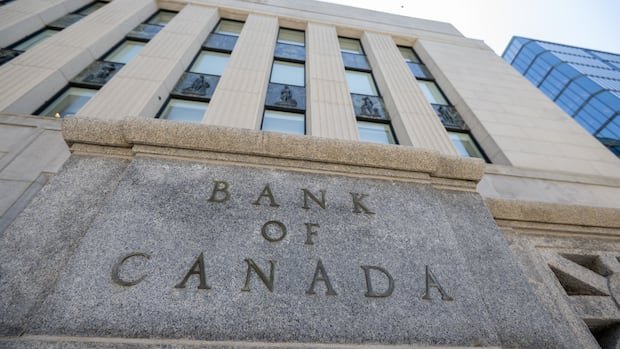The Bank of Canada cut its key interest rates to 2.25 per cent on Wednesday, continuing a rate cut cycle that began in June 2024.
Ahead of this latest change, CBC News spoke with economists, mortgage experts and financial planners who explained how interest rates work and what they see with each Bank of Canada announcement.
Here’s what lower interest rates mean for you, small businesses and the Canadian economy.
What are interest rates?
Interest is what consumers or institutions pay to borrow money. It’s also what a bank might pay a customer to leave money in their account.
When you take out a loan, “you’ll be given the cash and you’ll have to repay a small portion of that loan over time,” said Andrew DiCapua, senior economist at the Canadian Chamber of Commerce in Ottawa.
“Part of what that refund includes is interest.”
Commercial banks such as RBC, Scotiabank, TD Bank, CIBC, and BMO use “prime rates,” which are their initial rates to charge consumers who borrow money. That rate is usually combined with a percentage that is calculated based on a person’s creditworthiness.
Those prime rates are guided by the Bank of Canada’s overnight interest rate, a tool central banks use to keep inflation under control.
When inflation is too high, the Bank of Canada could raise that benchmark rate to discourage people from borrowing (and spending) money.
DiCapua said this could, for example, encourage someone buying a new car to “buy a smaller or cheaper car,” or delay buying a car altogether.
But when rates go down, borrowing money is cheaper. And that often encourages people to spend more, which can lead to economic growth.
Lower interest rates can mean different things for different parts of the economy. Therefore, the central bank balances potential growth with the risk of inflation when setting its reference rate.
How interest rates impact the real estate market

Homeowners (specifically those with a variable-rate mortgage) are among those who feel immediate relief when the Bank of Canada reduces its interest rate.
Your monthly mortgage payments will fluctuate as rates do.
Prospective homeowners might also be incentivized to jump into the market when lenders offer a lower variable rate, DiCapua said.
The lower benchmark rate could also help those potential buyers lock in a lower “fixed” mortgage rate, one that won’t fluctuate with future changes in interest rates.
September and October are typically the weakest months for markets, but this year’s rally continues to surprise. Not so surprising is Canada’s central bank’s decision last week to cut its key interest rate by 25 basis points. Foundation Wealth’s Mark Ting joins CBC’s Dan Burritt to discuss what it means for those looking for a mortgage.
That’s why a lower interest rate can lead to more home sales, which in turn can affect the economy. When rates trend lower, “we often see a psychological shift among buyers,” said Penelope Graham, mortgage expert at RateHub.ca.
“Simply eliminating that advantage with lower interest rates often stimulates more activity in the housing market, especially if people have the mentality of ‘if I don’t move now, I’ll miss out,'” he said.
How Interest Rates Affect Small Businesses
Without the burden of high housing payments, consumers could spend more of their budget purchasing goods and services, putting their money to work in other parts of the economy.
Those consumers “might have, for example, more disposable income to buy more products at retail stores or buy more experiences at hospitality businesses,” said Simon Gaudreault, chief economist and vice-president of research at the Canadian Federation of Independent Business.
Central banks often raise interest rates to control prices in times of inflation, but the Bank of Canada and the U.S. Federal Reserve simply lower rates. Andrew Chang explains how Trump’s tariffs and the labor market slump led to the same tipping point for the countries’ grieving economies. Images provided by Getty Images, The Canadian Press and Reuters.
Additionally, small businesses might have their own variable-rate mortgages or other loans (such as a manufacturing company that borrowed money to buy expensive equipment).
If the rate goes down, “it is good news for [those] business owners,” Gaudreault said.
But even as the central bank continues to cut rates, lower interest rates don’t automatically give businesses an optimistic outlook.
The Bank of Canada recently asked businesses how they feel about the economy, and the results were fairly muted, particularly in the context of a trade war that has made uncertainty the new normal.
As Gaudreault points out, companies are struggling with labor shortages and rising operating costs (such as insurance premiums), and the cost of resources has increased with inflation and tariffs.
“There is so much uncertainty right now, such weakness in the economy that companies have to be very, very careful about where they put their money,” Gaudreault said.
“There’s not a lot of money for new investments or new hires. They keep their money to deal with all those higher operating costs.”
How interest rates impact personal finances
When it comes to personal loans, like the auto loan example above, the cost of the loan will be reduced by prime rates, said Shannon Lee Simmons, a Toronto-based certified financial planner and founder of the New School of Finance.
The cost of borrowing money with a card or line of credit could also be reduced through cheaper debt payments, Simmons said.
If the cost of borrowing on a line of credit is high, then a new homeowner might postpone a renewal, for example. If rates go down, then they could use credit to finance that renovation.

But lower interest rates could be less welcomed by Canadians who are trying to save and grow their money because financial institutions will pay consumers less to hold on to their cash.
Getting lower interest payments from savings accounts and Guaranteed Investment Certificates (GICs) can be “frustrating,” Simmons said.
“But if you invest in the stock market and own fixed income products like bonds, typically speaking, when interest rates go down, bond prices will go up. And so it really depends on your asset mix,” he said.
What else do I need to know about the rate cuts?
“The relationship between interest rates and prices [depends] how fast or slow the economy is growing relative to its ability to produce goods and services,” DiCapua said.
When demand exceeds supply — and the economy requires more workers, more capacity or more machinery than is available — that can lead to higher prices, he explained.
But any changes in interest rates may take time to flow through the economy. The traditional view among economists is that these changes take about a year and a half, according to DiCapua.
“That’s because, of course, the lending rate affects the banks, the banks then change their rates and then those rates (the prime rate that banks use) then flow through the various financial instruments and loans through the system,” he said.

He said the Bank of Canada’s interest rate decisions are a clear signal to Canadians who want to know “where the economy is going.”
That signal can influence public confidence in the economy, which “can affect consumer behavior and business decision-making,” DiCapua said.
“That’s kind of the soft power, as I would put it, that the Bank of Canada has.”










